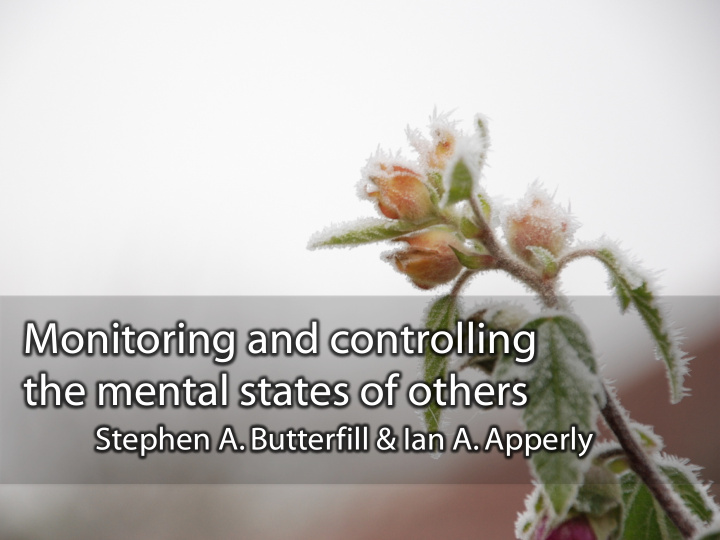



Monitoring and controlling the mental states of others Stephen A. Butterfill & Ian A. Apperly
!"#$%&'$"#()*'+&,)-.#/%'$"-/.%0)$&*'#$,) 122&%30)4)567&%833)9:;;<=) !"#$%&'()*& ) >.!)*6,/)?&)@&A"?3&) >.!)*6,/)?&)F',/)'#$)&G-"&#/) B)1#)'%-C&/02'3)D-&#/%'3)2%.-&,,E) B)1#)'%-C&/02'3)D*.$63'%)2%.-&,,E) H',/)4) H3&A"?3&I)
!"#$%&'%()*+)(,#&$-%+$#&.(#/(+(0%1#23%(24)($%,+&$#&.( +2#3#)5( !"#$%&'()****# • 6,7+#-%$(%1%'48"%(7-9'%//%/('+&(3%+$()9(/%"%-%( • %.9'%&)-#/,( :%;.;<(=+,/9&<(>77%-35<(?+)*#-.+,+&+)*+&(@(A4,7*-%5/<(BCCDE( – *# • #
!"#$%&'()*+*,-*./0.+2. . 345.673/(8"918":;<".%*=%>%;,*. 6+7#''*+8$,"#$3.9&+:/$ !"#$%&'()*%&+,$-.#/$01!$2+.3$3"#'#$,"#$.45#),$*/$ 7&;/#$4#;*#7$-.#/$01!$ '#<=*'#$>?@AB%#'/%#)(C#$ *+"*4*(.+$
!"#$%&'%()*+)(,#&$-%+$#&.(#/(+(0%1#23%(24)($%,+&$#&.( +2#3#)5( !"#$%&'()****# • 6,7+#-%$(%1%'48"%(7-9'%//%/('+&(3%+$()9(/%"%-%( • %.9'%&)-#/,( :%;.;<(=+,/9&<(>77%-35<(?+)*#-.+,+&+)*+&(@(A4,7*-%5/<(BCCDE( – F%3#%G(-%+/9&#&.(-%H4#-%/('9."%('9&)-93( • :%;.;<(F433<(I*#3#7/(@(J9&K+5<(BCCLE( – F%3#%G(#&G%-%&'%/(+-%(&9)( !"#$ (+4)9,+8'+335(( • :>77%-35<(=+,/9&<(M#../<(=#,7/9&(@(J*#+"+-#&9<(BCCNO(F+'P(@(>77%-35<( – BCQCE( F%3#%G(#&G%-%&'%/(+-%(&9)( %&$# (+4)9,+8'+335( • :%;.;<(?%5/+-<(R#&(@(F+--<(BCCSO(>77%-35(%)(+3;<(BCQCE( – A93$#&.(G+3/%(2%3#%G/(2-#%05(#&(,#&$(*+/(+(,%+/4-+23%( • 7-9'%//#&.('9/)( :>77%-35<(F+'P(%)(+3;<(BCCTE( – M%'4-/#9&(:%;.;<(2%3#%G/(+294)(2%3#%G/E(-%,+#&/('*+33%&.#&.( • !;.;<(U'P#&&9&(@(U9/'9"#)'*(:BCCLE( – $"%#+,#-+&.)/#0"#-10'%./"***# • *# • #
!"#$%&'%()*+)(,#&$-%+$#&.(#/(+&(%0'#%&)( 12)(#&3%4#15%(6-7'%//%/8( ( 9 !"#$%&'%(7:(#&"752&)+-;(#&:%-%&'%(7:<( 9 =#,65%("#/2+5(6%-/6%'>"%(?=+,/7&(%)(+5@A(BCDCE(
!"#$%&'()*+,-*+('.+/#&01234) 56&%-$27)!**+,897):,&1#;<&1#+)+#)&8=7)>?@?7) !"#$%## A ) ) 800 750 Reaction time (ms) 700 Consistent ns * 650 Inconsistent 600 550 500 Self - avatar distractor Self - rectangle distractor Experiment 3 B289)+.+,)C"D3+)E-+8FG)H);$<)%&29)D$#-) &'( )(&2)-++)
!"#$%&'%()*+)(,#&$-%+$#&.(#/(+&(%0'#%&)( 12)(#&3%4#15%(6-7'%//%/8( ( 9 !"#$%&'%(7:(#&"752&)+-;(#&:%-%&'%(7:<( 9 =#,65%("#/2+5(6%-/6%'>"%(?=+,/7&(%)(+5@A(BCDCE( 9 F.%&)G/(/6+>+5(:-+,%(7:(-%:%-%&'%(?HI#'J%55A(BCDDE( 9 F.%&)G/(K:+5/%(1%5#%:L(?M7"+'/(%)(+5@A(BCDCE( 9 =7,%>,%/(I#)*72)(%465#'#)(+I+-%&%//( 9 ='*&%#$%-(%)(+5@(?BCDDE( 9 N#)*72)(&%%$(:7-(K%4%'2>"%('7&)-75L( 9 O2-%/*#(%)(+5@(?BCDCE(
!"#$%&'()*&(+,-.(&/0"1'", G6HF)%$0,%&'()*&(+,.(&/0"1'", $(1,%&'()*&(,$2&3#,%&'()*4", $(1,%&'()*&(,$2&3#,56HF)%$0, 56"(&7"($8,, 56"(&7"($, 9:0$4"00,;<=<>,5?,<@AB, , , , CCC,"?'?,.(&/0"1'",&D,"EF8, CCC,"?'?,.(&/0"1'",&D, 2"0)"DF, #E$I"%#&E)"F,,
!"#$%&'()*+,$)-.')%(/0.,&,1/),*) -+#2'0-,+3'() :) E) F#870.) G$%#0-) 4.#-)5'6-,7)6,8&9).#:')9,7';;;;;) <=)>'+3:')'?8#@,7)*,+)-+#2'0-,+/),*)A#&&;) B=)>'+3:')'?8#@,7)*,+),7'C(),67)0#%#03-/)-,) $,:';) D,&:')<)#79)B)(3$8&-#7',8(&/) ) )
!"#$%&'()*+,$)-.')%(/0.,&,1/),*) -+#2'0-,+3'() !"#$%&'()*+,-./012(+34)&0"&*+5"0(-16"+78(90":-+;<=+>?@=AB*+ )
!"#$%&'()*+,$)-.')%(/0.,&,1/),*) -+#2'0-,+3'() 4'5-,63#6)$'0.#630().#()$70.)1+'#-'+)'"%+'((38')%,5'+()#69) • 1'6'+#&3(#:3&3-/)-.#6)6#;8')%./(30() <7-)-.3()0,$'()#-)-.')'"%'6('),*):'361)(&,5'+)#69)$,+')0,163=8'&/)0,(-&/) • -,)7(' )
!"#$%"$#&$'(&%)*+$,)-$./%01&2+$34"/+$+,&$5366)20$ "4.&*+-7$ !"#$%#&'$'"#()*$(+$'),-#.'()/#&$/&$ (01*$(+$1/2/'#3$4&#$ • 85"($+#"$(3+,&($%)9&(&2+$ (&3-"2-$ – !&$13:$2"+$,3;&$+,3+$+,&"(:$ – <;&2$)5$,&$,3-$+,3+$+,&"(:=$)+$ 13:$4&$+""$%)>*/6+$+"$/-&$)2$ (&36$?1&$ • @:$3236"0:=$+,&$4&-+$+,&"(:$"5$ 1&2+36$-+3+&-$13:$4&$"5$ 6)1)+&%$/-&$5"($/2%&(-+32%)20$ +,&$'-:*,"6"0:$"5$1)2%(&3%)20$
Ayesha believes Ayesha will cycle up Hármashatár hill Steve desires s/he will cycle up Hármashatár hill that Henry intends Henry will win the lottery ... ... ... Subject Attitude Content
Ayesha believes Ayesha will cycle up Hármashatár hill Steve desires s/he will cycle up Hármashatár hill that Henry intends Henry will win the lottery ... ... ... Subject Attitude Content
Ayesha believes Ayesha will cycle up Hármashatár hill Steve desires s/he will cycle up Hármashatár hill that Henry intends Henry will win the lottery ... ... ... Subject Attitude Content
minimal theory of mind
Your field = a set of objects related to you by proximity, orientation, lighting and other factors You encounter an object = it is in your field You register an object at a location = you most recently encountered the object at that location
Your field = a set of objects related to you by proximity, orientation, lighting and other factors You encounter an object = it is in your field You register an object at a location = you most recently encountered the object at that location proximity orientation lighting barriers trajectory
Your field = a set of objects related to you by proximity, orientation, lighting and other factors You encounter an object = it is in your field You register an object at a location = you most recently encountered the object at that location proximity orientation lighting barriers trajectory
Your field = a set of Principle 1: one can’t goal- objects related to you by directedly act on an object unless proximity, orientation, one has encountered it. lighting and other factors Principle 2: correct registration is a You encounter an object = condition of successful action. it is in your field Principle 3: when an agent performs You register an object at a a goal-directed action and the goal location = you most specifies an object, the agent will recently encountered the act as if the object were actually in object at that location the location she registers it at. proximity orientation lighting barriers trajectory
Your field = a set of Principle 3: one can’t goal- objects related to you by directedly act on an object unless proximity, orientation, one has encountered it. lighting and other factors Principle 2: correct registration is a You encounter an object = condition of successful action. it is in your field Principle 3: when an agent performs You register an object at a a goal-directed action and the goal location = you most specifies an object, the agent will recently encountered the act as if the object were actually in object at that location the location she registers it at. proximity orientation lighting barriers trajectory
Your field = a set of Principle 1: one can’t goal- objects related to you by directedly act on an object unless proximity, orientation, one has encountered it. lighting and other factors Principle 2: correct registration is a You encounter an object = condition of successful action. it is in your field Principle 3: when an agent performs You register an object at a a goal-directed action and the goal location = you most specifies an object, the agent will recently encountered the act as if the object were actually in object at that location the location she registers it at. proximity orientation lighting barriers trajectory
Your field = a set of Principle 1: one can’t goal- objects related to you by directedly act on an object unless proximity, orientation, one has encountered it. lighting and other factors Principle 2: correct registration is a You encounter an object = condition of successful action. it is in your field Principle 3: when an agent performs You register an object at a a goal-directed action and the goal location = you most specifies an object, the agent will recently encountered the act as if the object were actually in object at that location the location she registers it at. proximity orientation lighting barriers trajectory
Recommend
More recommend